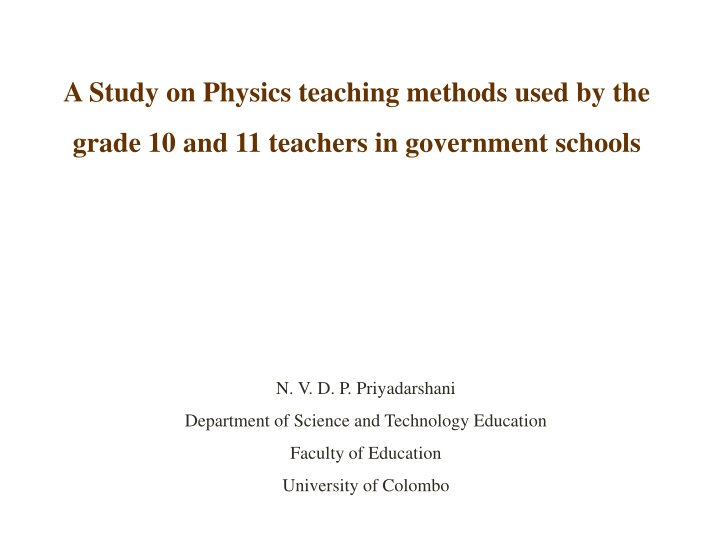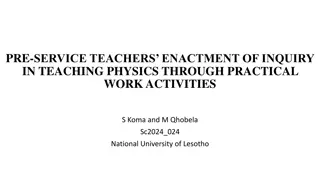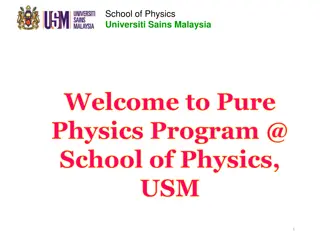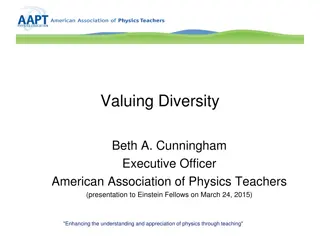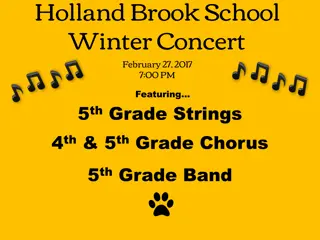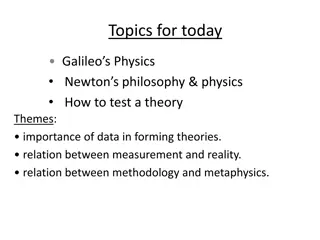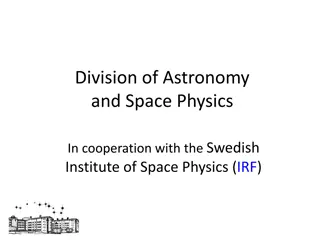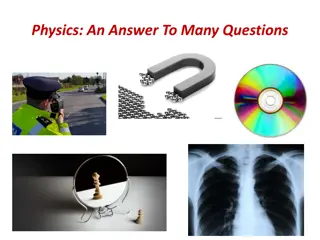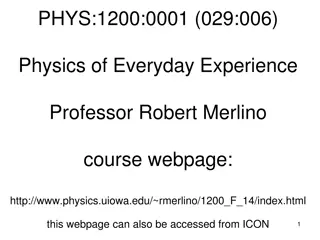Analysis of Physics Teaching Methods in Grade 10 & 11 Government Schools
This study investigates the effectiveness of physics teaching methodologies in grade 10 and 11 government schools in Sri Lanka. The research aims to examine the alignment between prescribed teaching methods and their actual implementation by teachers. By analyzing textbooks, teachers' guides, and engaging with teachers and students, the study seeks to identify challenges and improve student achievement levels in physics education.
Download Presentation

Please find below an Image/Link to download the presentation.
The content on the website is provided AS IS for your information and personal use only. It may not be sold, licensed, or shared on other websites without obtaining consent from the author.If you encounter any issues during the download, it is possible that the publisher has removed the file from their server.
You are allowed to download the files provided on this website for personal or commercial use, subject to the condition that they are used lawfully. All files are the property of their respective owners.
The content on the website is provided AS IS for your information and personal use only. It may not be sold, licensed, or shared on other websites without obtaining consent from the author.
E N D
Presentation Transcript
A Study on Physics teaching methods used by the grade 10 and 11 teachers in government schools N. V. D. P. Priyadarshani Department of Science and Technology Education Faculty of Education University of Colombo
Background The G.C.E (O/L) is one of the main examinations in Sri Lanka. Science is the main and compulsory subject which the student has to learn. According to the new syllabus, Science subject is divided into three parts namely; Physics, Chemistry and Biology.
Cont.. In school text books, all the relevant theories and practical methods are clearly indicated. For the teachers, teaching methodologies are clearly indicated in the teaching guide. But due to the lack of usage of those teaching methodologies effectively by teachers, student achievements are not in acceptable level.
Objectives The main objectives of this research were, Examining the teaching methodologies given in grade 10 & 11 text books related to subject Physics. Examining how far identified teaching methodologies are used by teachers in grade 10 & 11 Physics. Identifying the problems related to teaching methodologies in grade 10 & 11 Physics.
Research Design This research was a mixed method research. For examining the teaching methodologies given in grade 10 & 11 text books related to subject Physics. (1st objective) Science text books of grade 10 & 11 Teachers guide of grade 10 &11 For examining the teaching methodologies of grade 10 & 11 Physics (2nd objective) Teachers and Students in government schools of the Colombo district.
Sample selected from Colombo district Sinhala medium schools Selected Schools Zone Division 1AB 3 1C 1 Type 2 Maharagama Sri Jayawardenapura Nugegoda 2 Sri Jayawardenapura Kolonnawa 1 1 Sri Jayawardenapura Dehiwala 2 Piliyandala Colombo- South 1 Colombo Teachers 50 Students 70
Methodology To identify the current situation of the subject science in G.C.E (O/L) examination, 2013, 2014 and 2015 result sheets were examined. Furthermore evaluation reports of years 2014 and 2015 G.C.E (O/L) examinations were examined to clarify the student interest of selecting questions and what kind of marks they obtained by selecting those questions. To exam the teaching methodologies given in grade 10 & 11 text books related to subject Physics, Science text books of grade 10 &11 and Teachers guide of grade 10 &11 were used to identify the subject content of the syllabus which is related to the Physics part of grade 10 &11 in the subject Science.
Cont. That subject content was examined in descriptive manner and identified the student centred activities and teacher centred activities. To examine how far identified teaching methodologies were used by teachers in grade 10 & 11 Physics, data were gathered from students and teachers using Questionnaire Interviews Observation Also those tools are used to collect the data for identifying the problems related to teaching methodologies in grade 10 & 11 Physics.
Results/ Findings G.C.E(O/L) Examination 2013, 2014 and 2015 Results analysis 2013 264323 25506 9.65 18786 7.11 43989 16.64 90204 34.13 178485 67.53 85838 32.47 2014 257002 19642 7.64 13939 5.42 40296 15.68 81808 31.83 155685 60.58 101317 39.42 2015 272865 24270 8.89 21072 7.72 49778 18.24 90474 33.16 185594 68.02 87271 31.98 Total Student A % B % C % S % Pass(A,B,C,S) % W %
Evaluation reports of years 2014 G.C.E (O/L) examinations Percentage Marks Mark s percentage Question 9 63.95 23.85 8.97 3.22 Question 10 50.88 25.58 17.27 6.26 0 -3 4 7 8 11 12 15 0 -25 % 26 50 % 51 75% 76 100% Evaluation reports of years 2015 G.C.E (O/L) examinations Percentage Marks Marks percentage Question 10 55.82 22.27 16.43 5.48 Question 9 57.07 25.74 11.17 6.03 0 -3 4 7 8 11 12 15 0 -25 % 26 50 % 51 75% 76 100%
According to the 2013, 2014 and 2015 result sheets of the science subject in G.C.E (O/L) examination, it indicates 32.5%, 39.4% and 31.9% failed participants respectively. So it means there are some problems related to the teaching learning process. According to the G.C.E (O/L) examination evaluation report of the subject Science in year 2014 and 2015, it says that most of the students have 0 -3 mark out of 15 and there are only few percentage for marks between 12 to 15.
Considering the subject content of the Physics part in descriptive manner, there are 9 chapters for Physics part in grade 10 Science text book and it is 45% of the overall content. For that 58 periods are allocated and it is 35% from the number of total periods. Considering the grade 11, there are 6 chapters for the Physics part in Science text book and it is 42.8% from the overall. For that 54 periods are allocated and it is 39% from the number of total periods.
Physics Chemistry Biology Total Assignments Assignments Assignments Chemistry Activities Activities Activities Exercises Exercises Exercises Biology Physics 26 0 17 18 13 2 22 17 0 43 33 39 Total 43 33 39 115 % 37.4 28.7 33.9 Student centered activities in grade 10 science text book
Physics Chemistry Biology Total Assignments Assignments Assignments Chemistry Activities Activities Activities Exercises Exercises Exercises Biology Physics 28 3 9 37 12 0 14 12 0 40 49 26 Total 40 49 26 115 % 34.8 42.6 22.6 Student centered activities in grade 11 science text book
Data analysis from students questionnaire Percentage Satisfactory Excellent Marginal Average Good Not Factor 5.7 6.1 0.0 4.3 0.0 28.6 7.6 22.4 15.9 12.9 25.7 53.0 41.8 20.3 17.1 27.1 24.2 25.4 26.1 32.9 12.9 9.1 10.4 33.3 37.1 Your desire for physics The relevance to everyday life It's easy to understand the subject Satisfied with the teacher Does the teacher properly teach? Are you satisfied with the teacher's subject knowledge? Teacher performs practical examinations. Existing equipment for practical Teacher has sufficient knowledge to conduct experiments. After the lesson the teacher evaluates you Teacher pay attention to weak students. 1.4 5.8 18.8 23.2 50.7 10.6 12.9 9.1 20.0 16.7 22.9 24.2 24.3 39.4 20.0 1.5 6.1 22.7 24.2 45.5 12.3 8.8 9.2 8.8 27.7 14.7 26.2 29.4 24.6 38.2
Data analysis from Teachers questionnaire Percentage Satisfactory Excellent Marginal Average Good Not Factor 0.0 0.0 0.0 0.0 0.0 0.0 2.2 0.0 0.0 2.2 0.0 4.3 13.3 8.9 10.9 13.0 13.0 30.4 68.9 80.0 58.7 69.6 56.5 58.7 15.6 11.1 30.4 15.2 30.4 6.5 Practical testing Understanding equipment Understanding the subject knowledge Understand the imposition of equipment Understand the safety of equipment Understanding substitute equipment
The problems related to teaching methodologies in grade 10 & 11 Physics. Speeding up the lesson Do not explain the lesson well Holding additional classes Conducting question papers Avoiding the some part of the lesson Complex lessons - Friction - Equilibrium of forces - Geometrical Optics - Newton s laws of motion - Electromagnetism and Electromagnetic Induction - Current Electricity - Electronics - Heat
Suggestions from Students and Teachers Sufficient place, equipment and time to do the practical Reduce the lesson content or amount Introduce simple experiments Conduct seminars for complex lessons Increase student centered activities
Conclusions Examining the grade 10 & 11 science text book, there are 37.4% and 34.8% student centred activities respectively but the problem is enough time is not allocated for the Physics part compared to the other parts; Chemistry and Biology. Also due to the lack of adequate resources and teachers capability for organizing the lesson, teachers use some of the student centred activities as demonstration or using a suitable other teacher centred methods. So that there is no enough chances to gather the knowledge from effective teaching methods.
References Alles, J. (1985) Sri Lanka Tha Report of the Science Education,UNESCO. Biegeleison, J. I. (1969 ) Career and opportunities in teaching. New York : Dutton Howe, H. In Donald J. Maccadthy and associates, Jossey Bass Inc. california. USA Kerlinger, F. N.(1983). Foundation of Behavioural Research. New Delhi : Surjeet Publication. Kotasek, J. (1975) Education on the move. Paris : UNESCO Nicholls, S. H. (1975) Creative Teaching. London : Uniwin Ltd. Schmidbauer, M. (1975) Education on the move. Paris : UNESCO
Cont. Yadev,M.S.(1992). Teaching of Science. New Delhi : Anmol Publications Grade 10 Science text book (2015), Education Publication Department Grade 11 Science text book (2016), Education Publication Department Teacher s Guide Grade 10 (2015), National Institute of Education Teacher s Guide Grade 11 (2016), National Institute of Education G.C.E (O/L) examination evaluation report of Science subject in year 2014 and 2015 G.C.E (O/L) examination result sheet in year 2013, 2014 and 2015
